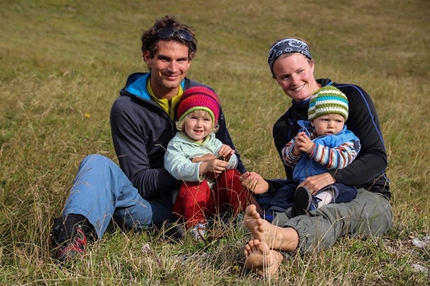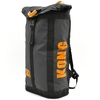San Vito Lo Capo. Full stop and start over again.

 1 / 8
1 / 8 Elio Bonfanti
Elio Bonfanti
Before starting to describe the current situation however, it seems only right to express our great sorrow for Stefan’s injury, and we are happy and relieved to learn that he has woken up from his coma. We wish him best wishes for his recovery.
SAN VITO LO CAPO - THE BEGINNINGS
The numerous crags and more than a thousand routes at San Vito, as in most places in Italy or perhaps in the rest of the world, came about spontaneously thanks to the work of first ascentionists who invited their own time, money and effort. Unlike in other parts of Italy, where the local climbers developed their own areas, at San Vito many crags were developed quickly by many (too many!) different climbers, Italians and foreigners, who wished to leave their mark. While this helped rapidly increase the number of sectors and routes (circa 1000 at present), it also resulted in a considerable difference in bolting style between one climb and the next. And the word style should be interpreted in its broadest sense, namely type of gear used, distance between one anchor and the next, the choice of which portion of the face the route is on and the choice of route cleaning.
NEW ROUTERS
The sequence of events that lead to a new sector being developed (identification, creation of an access path, proper removal of loose rock, type of gear and distance between the bolts) has created other problems. Unfortunately, we have to note that not everyone takes the utmost care in checking and carrying out the meticulous removal of unsafe rock. It is also true that a route, cleaned and bolted five or six years ago, might be in a completely different state nowadays, due for example to rainwater seepage or due to roots that grow and and break the rock.
CORROSION IN A MARINE ENVIRONMENT
The gear issue, already addressed in articles, press conferences and long discussions, plays a considerable role in the quality the routes at San Vito. The big problem of stainless steel corrosion in marine environments came to a forefront during the year when new routes were being bolted at San Vito, without the that necessary attention about the stainless steel issue. The raw material used in the vast majority of bolts (stainless steel 304 or what is presumed to be such) proved inadequate. A special mention must be made for the Bolt Product gear used by the Titt brothers who bolted hundreds of routes with Duplex steel which, although not particularly popular due to the shape and size (the famous pig tails and intermediate pro), so far have showed no signs of corrosion. Unfortunately, the proximity to the sea, the particular exposure of some areas, and other factors related to the rock type all significantly compromise the durability and strength of normal stainless steel. Experience in the field, broken bolts or significantly corroded bolts have led us to be wary about certain anchor types and, consequently, the routes that have been bolted with these.
RECENT EVENTS
First and foremost we refute the information contained in the article by Elio Bonfanti published by Planet Mountain according to which, this year alone, there have been seven accidents due to the precarious nature of the rock and anchors. What is true is that there have been some accidents in recent years, but a large part of these were due to the inexperience of the climbers who committed serious “technical" mistakes. In two cases, however, the accidents were due to holds or portions of rock breaking that injured climbers. Even if we never wish this to happen, unfortunately a number of holds and portions of rock breaking is almost “physiological" in an area that is highly popular and has over a thousand rock climbs.
The event recounted in Michel Piola’s open letter is a completely different issue. The French team were climbing “La collina dei conigli" on Monte Monaco when a belay anchor broke during an abseil. Fortunately tragedy was averted thanks to the second anchor.
In the aforementioned letter Michel Piola even appealed to the authorities to ban climbing in all of San Vito. While we hugely respect someone he who has thousands of routes to his name, it would nevertheless be desirable that warning cries of this magnitude be made only after careful analysis and verification of "all San Vito", after having checked and communicated with all those who live and attempt to manage the region.
WHAT MUST BE DONE
Having said that, we’re the first to admit that critical issues have been detected, some significantly affect the safety of a route that consequently requires a complete makeover, others need not much more than a routine check.
In our opinion, based on our field knowledge and reports received from climbers, urgent action must be carried out as follows:
Sectors, or large parts of sectors, that need rebolting. Deemed unsafe until the works are completed.
a) Cattedrale nel Deserto (the first 10 routes were rebolted in 2013, but all routes in the central section and in the righthand sector need rebolting, circa 25)
b) Lost Word (13 routes)
c) Grotta dei Santi (9 route)
- All the routes with just one lower-off anchor (most are located on the Salinella outcrop between Torre Isulidda and Camping). Of the circa 250 routes in this section, circa half have only one lower-off anchor, or an insufficient anchor.
- Routes that need rebolting in other sectors - the following routes need rebolting, because considered unsafe, all routes equipped with old 304 stainless steel anchors, and all those with obvious signs of corrosion. (e.g. various routes at Nuova Ossesione, Crown between the main sectors).
However, many of the routes at Salinella, where we will change and substitute the lower-off anchors in the next few days, have been bolted with duplex stainless steel that seems to provide good resistance to salt corrosion.
WORKS CARRIED OUT SO FAR
It is important to remember that since 2009 the Rocce di Sicilia association checks the state of the routes that host the Climbing Marathon during the annual festival. This is long and demanding process of checking and, where necessary, removing loose rock, as well as replacing corroded anchors.
The real work of route maintenance began in 2013 during the Bolting edition where, thanks to the finical support of the AOTS Associazione Operatori Turistici SanVitesi and the El Bahira and La Pineta campsites, 316L stainless steel anchors were purchased for 50 routes. 42 climbs (located between the sectors Cattedrale nel Deserto, Bunker and Canalino) were rebolted and 8 routes were added to the sector Valanga, aimed as a sector to teach bolting in collaboration with the Mountain Guides Massimo Faletti and Stefano Perrone.
Furthermore, last spring in preparation for the Festival circa 60 routes were checked, cleaned and loose rock removed from Portella delle vacche to beyond the sector Bunker.
IMMEDIATE ACTION
An important reference point has been created at San Vito Lo Capo thanks to the opening of Climbing House, not only for the climbers but also for the development of climbing in this area. In fact, right from the outset a bolting fund was created. To date, thanks to the donations made by the many visiting climbers, over two thousand euro have been raised and used already to purchase anchors and belays in FIXE 316 L marine stainless steel. The entire Lost World sector will soon be rebolted and all the lower-offs at Scogliera di salinella from Torre Isulidda to the campsite El Bahira will be made safe.
A special mention goes to Aosta Valley mountain guide Matteo Giglio who immediately offered to revolt his splendid “La collina dei conigli" on Monte Monaco which was severely affected by the sea salt. Works have already begun and the entire route will obviously be rebolted with marine 316L resin bolts. By the end of the year this route will be completed.
Furthermore, in collaboration with local tourist office Operatori Turistici Sanvitesi the project "Adopt a climb - Titanium Project” has been launched. This is an ambitious and costly project, but as the representative of San Vito explained, “we want the best”. The project, put simply, gives everyone the chance to adopt an existing climb. The contribution asked for will enable the route to be completely restyled, from the lower-off belay to the intermediate anchors along the route. All of this obviously in titanium, currently the only material that guarantees unlimited corrosion resistance. This is a fundamental contribution to climbers’ safety and to the long-term future of the heritage of rock climbs at San Vito Lo Capo. The Titanium Project will begin by revolting routes at Cattedrale nel deserto, which seem those most at risk of the above mentioned corrosion.
At the forefront of these works are Daniele and Ivan of the Climbing House. Obviously there is much to be done and expert helping hands will be be gratefully accepted.
FUTURE PLANS
- Rules will be adopted, with guidelines for future bolting in the area.
A bank account will be opened for donations for all those who wish to provide financial support in order to collect the funds needed to purchase the gear
An agreement will be made with hotels/B&B’s to offer free hospitality to all those who wish to lend a hand at reequipping the routes.
All routes and sectors checked will be included in a list, available on-line in the festival site (www.sanvitoclimbingfestival.it) and the YMCA Climbing House (www.ymcaclimbingsanvito.it)
Massimo Cappuccio (Associazione Rocce di Sicilia)
Peppe Gallo (Associazione Rocce di Sicilia)
Daniele Arena (Ass. YMCA Climbing House San Vito lo Capo)
Ivan Savoi (Ass. YMCA Climbing House San Vito lo Capo)



 Copia link
Copia link






 See all photos
See all photos






















